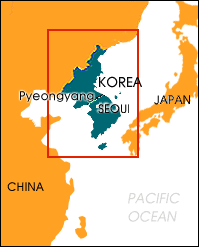






| |
|
|

|
The Korean
Peninsula extends southward from the northeastern part of the Asian
continent between latitudes from 33 to 43 degrees North, and
longitudes from 124 to 131 degrees East.
The standard
meridian of the peninsula is 135 degrees, 9 hours ahead of GMT. The
Amnok and Tuman Rivers border both China and Russia to the north,
and Japan lies just across the East Sea.
Since 1945, as a
result of the Cold War, the peninsula has been divided into two
parts: the democratic Republic of Korea, or South Korea, and
communist Democratic People's Republic of Korea, or North Korea.
|
The
total area of the peninsula is 222,196 square kilometers, similar in size
to that of Britain, New Zealand, or Romania. South Korea occupies 99,434
square kilometers or 45 percent of the total land mass, and North Korea
the remaining 122,762 square kilometers. Seventy percent of the land is
covered with mountains, particularly to the north and east.
Along the southern and
western coasts, the mountains descend gradually into broad coastal plains.
Most of the rivers
have their tributaries in the northern and eastern sides, and flow into
the West and South Seas. Concentrated for the most part on the southern
coast are more than 3,000 islands of various sizes that provide a scenery
that is unparalleled by any other place in the world.
|

|
Koreans, like many
other Asian peoples, are descendants of Mongolian Tungus stock.
However, they differ from their neighbors, the Japanese and Chinese,
in that they are a homogeneous ethnic group with their own language,
culture, and customs.
Korean people
are characterized by their generosity, warmth, and kindness, and are
renowned as one of the hardest working people in the world.The
following data show main figures of Korea (as of the end of 1999).
 | Population:
South Korea - 46.84 million (North Korea - 22.08 million)
|
 | Annual
growth rate of population: 0.92%
|
 | Average
family size: 3.3 persons
|
 | Number
of foreign residents: 55,016 (National
Statistical Office, 1995)
|
|
|

|
The Korean flag is
called Taegeukgi. Its design symbolizing the principles of yin and
yang is from Asian philosophy. The circle in the center of the flag
is divided into two equal parts.The upper red section represents the
positive cosmic forces of yang. Conversely, the lower blue section
represents the negative cosmic forces of yin.
The two forces
together embody the concepts of continual movement, balance, and
harmony that characterize the sphere of infinity. The circle is
surrounded by four trigrams, one in each corner. Each trigram
symbolizes one of the four universal
|
|
|
elements :
|

|
|

|
The national flower
of Korea is Mugunghwa, Rose of Sharon. Every year from June to
October a profusion of Mugunghwa blossoms grace the entire country.
Unlike most flowers, Mugunghwa is remarkably tenacious and is able
to withstand both blight and insects.
Its symbolic
significance stems from Mugunghwa's root word, "Mugung,"
meaning immortality. This word accurately reflects the perseverance
and determination that the Korean people have demonstrated
throughout their long history.
|
|

|
The
Korean language is classified as a Ural-Altaic language, a group
which also includes Mongolian, Hungarian, and Finnish. The Korean
character system, Hangeul, is completely different from Japanese.
"Hangeul" was developed by a group of scholars under the
patronage of King Sejong in 1443 of the Joseon Dynasty.
It is composed
of 10 vowels and 14 consonants. This unique phonetic syllabic system
allows great freedom of expression. The Hangeul Romanization, which
was last revised in July 2000, is based on standard Korean
pronunciation and differs substantially from the old McCune-Reischauer
(M-R) system.
|
|
|







